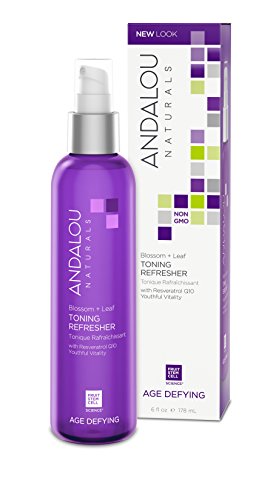
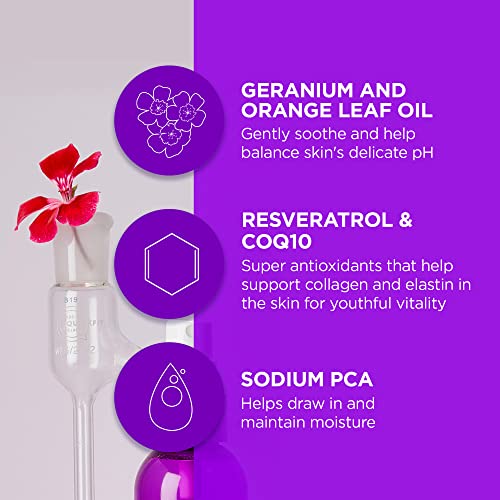


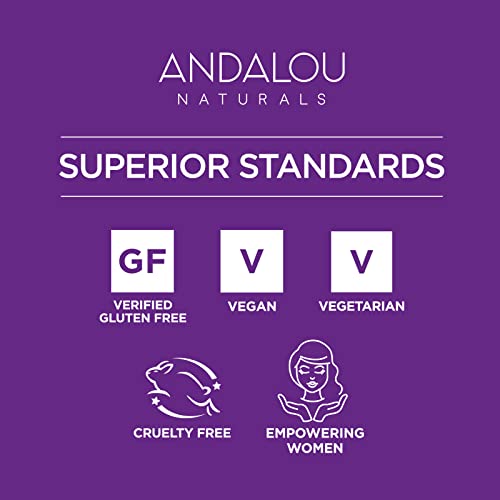
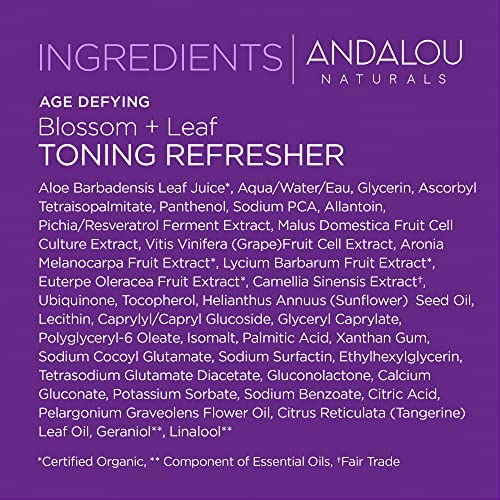
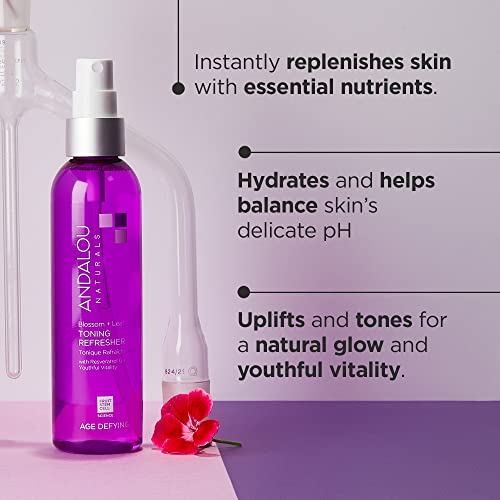
Andalou Naturals Face Toner - Hydrating with Resveratrol & Aloe, 98% Nature-Derived - 6oz


Pelargonium Graveolens (Geranium) Flower Oil
High RiskPelargonium graveolens (geranium) flower oil is a volatile essential oil extracted from the leaves and stems of the Pelargonium graveolens plant. It is commonly used in cosmetics for its fragrance and potential skin benefits. This oil is characterized by its floral scent and is often included in formulations for aromatherapy, skincare, and personal care products.
Sustai Insights
Pelargonium graveolens flower oil offers functional benefits such as fragrance enhancement in cosmetic formulations. However, it has a high allergenic potential, posing risks of skin irritation and sensitization. Environmental concerns include its potential as a pollutant, though it is not bioaccumulative. Regulatory bodies do not currently restrict its use, but safety assessments are essential due to its allergenic properties. Overall, the ingredient carries a high risk level, necessitating cautious use, especially for sensitive populations. Alternatives such as synthetic fragrance compounds may mitigate allergenic risks.
Phenethyl Alcohol
Medium RiskPhenethyl alcohol is an aromatic alcohol commonly used in cosmetic formulations. It functions primarily as a solvent and a preservative, contributing to product stability and enhancing the fragrance profile.
Sustai Insights
Phenethyl alcohol exhibits functional benefits as a preservative and solvent in cosmetic products, with some sustainability credentials due to its natural origin. However, it is associated with moderate allergy concerns and low risks of carcinogenicity and reproductive toxicity. Regulatory bodies have imposed specific use restrictions, highlighting the need for cautious application. Overall, the risk assessment indicates a medium risk level, warranting safe usage practices and consideration of alternatives like natural preservatives.
Ubiquinone
Medium RiskUbiquinone, also known as coenzyme Q10, is a naturally occurring antioxidant found in the body, primarily in the mitochondria. It plays a crucial role in energy production and is commonly used in skincare and dietary supplements for its potential health benefits and ability to support cellular function.
Sustai Insights
Ubiquinone provides functional benefits as an antioxidant, aiding in energy production and skin health. It is generally considered safe, with low risks for carcinogenicity, allergies, and immunotoxicity, although moderate concerns exist regarding developmental and reproductive toxicity and certain usage restrictions. Environmental impacts are minimal, with no significant bioaccumulation noted. Regulatory bodies do not impose severe restrictions, but users should adhere to recommended concentrations. Overall, this ingredient presents a medium risk level, and alternatives like alpha-lipoic acid may be considered for those seeking different antioxidant options.
Allantoin
Low RiskAllantoin is a naturally occurring nitrogenous compound found in various plants and animals. It is commonly used in cosmetic formulations for its soothing and moisturizing properties, as well as its ability to promote skin cell turnover and healing.
Sustai Insights
Allantoin offers functional benefits such as skin soothing, hydration, and promoting cell regeneration. It is generally recognized as safe, with low concerns regarding carcinogenicity, allergies, and reproductive toxicity. Environmentally, it poses minimal risks, being biodegradable and sustainably sourced. Regulatory bodies do not impose significant restrictions on its use. Overall, the risk level associated with allantoin is low, making it a favorable ingredient in personal care products.
Panthenol, D
Low RiskPanthenol, also known as provitamin B5, is a humectant commonly used in cosmetic and personal care products. It functions primarily as a moisturizer, enhancing skin hydration and improving the appearance of hair by imparting shine and softness.
Sustai Insights
Panthenol is effective in retaining moisture, thus providing functional benefits for skin and hair care products. It is generally recognized as safe, with low concerns regarding carcinogenicity, allergies, and developmental toxicity. However, potential cumulative exposure from multiple sources exists. Environmental risks are minimal, and it is not bioaccumulative. Regulatory bodies have not issued significant warnings; therefore, the overall risk level is assessed as low. For optimal use, it is recommended to follow product guidelines, and alternatives such as glycerin may also be considered for moisturizing effects.
Sorbitan Oleate Decylglucoside Crosspolymer
Low RiskSorbitan oleate decylglucoside crosspolymer is a synthetic polymer derived from sorbitan oleate and decylglucoside. It functions primarily as an emulsifier and thickening agent in cosmetic and personal care products, aiding in the stabilization of formulations and improving texture.
Sustai Insights
Sorbitan oleate decylglucoside crosspolymer offers functional benefits as an effective emulsifier and stabilizer, enhancing product consistency. It has low health risk concerns related to carcinogenicity, allergenic potential, and reproductive toxicity. Environmentally, it presents low bioaccumulation and pollution risks. Regulatory bodies do not impose restrictions on its use. Overall, its risk level is assessed as low, making it a suitable ingredient in formulations.
Ethylhexylglycerin
Low RiskEthylhexylglycerin is a glyceryl ether utilized primarily as a skin-conditioning agent and preservative in cosmetic formulations. It enhances the efficacy of preservatives and serves as a humectant, helping to retain moisture in the skin. This ingredient is commonly found in various personal care products.
Sustai Insights
Ethylhexylglycerin offers functional benefits as an effective preservative and skin-conditioning agent, contributing to product longevity and moisture retention. Health risks are generally low, with minor concerns regarding allergic contact dermatitis and irritant potential. Environmentally, it poses minimal risks, not being recognized as a pollutant or bioaccumulative. Regulatory bodies have imposed few restrictions, indicating its safety for use. Overall, its risk level is assessed as low, making it a viable option in cosmetic formulations. For those seeking alternatives, ingredients like propanediol may serve similar functions with potentially lower irritation profiles.
Tocopherol, D Alpha
Low RiskTocopherol, specifically d-alpha tocopherol, is a naturally occurring form of Vitamin E. It is commonly used in cosmetic and personal care products primarily for its antioxidant properties, helping to protect formulations from oxidation and extend shelf life.
Sustai Insights
D-alpha tocopherol provides effective antioxidant benefits, contributing to product stability. It is sustainably sourced and generally regarded as safe, with low concerns regarding carcinogenicity, allergies, and reproductive toxicity. However, there are minor concerns about endocrine disruption. Regulatory bodies have not imposed significant restrictions, indicating low overall risk. Recommended usage practices include adhering to established safe concentration thresholds. Alternatives, such as other forms of Vitamin E or plant-based antioxidants, may also be considered.
Magnesium Ascorbyl Phosphate
Low RiskMagnesium ascorbyl phosphate is a vitamin C derivative used in cosmetics primarily for its antioxidant properties and skin-brightening effects. It is often included in formulations for its ability to stabilize vitamin C, enhancing its efficacy in skin care products.
Sustai Insights
Magnesium ascorbyl phosphate offers functional benefits as an effective antioxidant and skin-brightening agent, contributing to improved skin appearance. It has a low risk profile concerning health, with minimal concerns regarding carcinogenicity, allergies, and reproductive toxicity. Environmental risks are also low, with no significant pollutant or bioaccumulation potential noted. Regulatory assessments indicate no major restrictions, supporting its safe use in cosmetic products. Overall, the ingredient is assessed as low risk, with safe usage practices recommended for optimal effectiveness.
Resveratrol
Low RiskResveratrol is a natural polyphenolic compound found in various plants, notably in the skin of grapes. It is commonly used in cosmetic formulations for its antioxidant properties and potential to enhance skin health. Its primary function in products includes acting as a stabilizer and providing skin protection.
Sustai Insights
Resveratrol offers functional benefits as a powerful antioxidant, potentially enhancing skin health and providing environmental protection. It poses low health risks, with minimal concerns regarding carcinogenicity, allergies, and reproductive toxicity. Environmental risks appear low, with no evidence of bioaccumulation. Regulatory bodies do not currently restrict its use. Overall, it presents a low-risk profile, making it a suitable ingredient with no significant safety concerns.
Aspalathus Linearis (Rooibos) Extract
Low RiskAspalathus linearis extract is derived from the leaves of the rooibos plant, commonly used in beverages and cosmetic products for its antioxidant properties and potential skin benefits. It is known for its high content of flavonoids, which contribute to its functional role in formulations.
Sustai Insights
Aspalathus linearis extract offers functional benefits such as antioxidant properties and skin soothing effects, making it a valuable ingredient in cosmetics. It is sustainably sourced and poses low health risks, including negligible concerns for carcinogenicity and allergies. Environmental risks are minimal, with no significant pollutants or bioaccumulation issues. Regulatory assessments indicate no restrictions, reflecting its safe use in various applications. Overall, it is assessed as low risk, with no substantial adverse effects noted, making it a suitable choice for consumers.
Hibiscus Sabdariffa (Roselle) Flower Extract
Low RiskHibiscus sabdariffa (roselle) flower extract is derived from the calyx of the hibiscus plant, used primarily for its potential antioxidant properties and as a natural colorant in various cosmetic and food products.
Sustai Insights
Hibiscus sabdariffa flower extract offers functional benefits such as antioxidant properties and natural coloring, while being sustainably sourced with low environmental impact. Health risks, including irritant potential, are minimal, and it is not classified as a carcinogen or allergen. Regulatory status is favorable, with no current restrictions. Overall, the risk level is assessed as low, making it a safe choice in formulations.
Sodium Pca
Low RiskSodium PCA is a derivative of naturally occurring amino acids and is primarily used in cosmetics for its moisturizing properties. It acts as a humectant, attracting and retaining moisture in the skin, thereby enhancing hydration and improving skin texture.
Sustai Insights
Sodium PCA offers functional benefits as an effective humectant, enhancing skin moisture levels. It is derived from natural sources, supporting sustainable practices. Health risks are low, with minimal concerns regarding carcinogenicity, allergies, or reproductive toxicity. Environmental risks are also low, as it is not known to be bioaccumulative or a significant pollutant. Regulatory bodies have not placed significant restrictions on its use. Overall, it presents a low risk profile, making it a suitable ingredient in cosmetic formulations. Alternatives may include other humectants like glycerin or hyaluronic acid.
Pelargonium Graveolens (Geranium) Flower Oil
High RiskPelargonium graveolens (geranium) flower oil is a volatile essential oil extracted from the leaves and stems of the Pelargonium graveolens plant. It is commonly used in cosmetics for its fragrance and potential skin benefits. This oil is characterized by its floral scent and is often included in formulations for aromatherapy, skincare, and personal care products.
Sustai Insights
Pelargonium graveolens flower oil offers functional benefits such as fragrance enhancement in cosmetic formulations. However, it has a high allergenic potential, posing risks of skin irritation and sensitization. Environmental concerns include its potential as a pollutant, though it is not bioaccumulative. Regulatory bodies do not currently restrict its use, but safety assessments are essential due to its allergenic properties. Overall, the ingredient carries a high risk level, necessitating cautious use, especially for sensitive populations. Alternatives such as synthetic fragrance compounds may mitigate allergenic risks.
Allantoin
Low RiskAllantoin is a naturally occurring nitrogenous compound found in various plants and animals. It is commonly used in cosmetic formulations for its soothing and moisturizing properties, as well as its ability to promote skin cell turnover and healing.
Sustai Insights
Allantoin offers functional benefits such as skin soothing, hydration, and promoting cell regeneration. It is generally recognized as safe, with low concerns regarding carcinogenicity, allergies, and reproductive toxicity. Environmentally, it poses minimal risks, being biodegradable and sustainably sourced. Regulatory bodies do not impose significant restrictions on its use. Overall, the risk level associated with allantoin is low, making it a favorable ingredient in personal care products.
Panthenol, D
Low RiskPanthenol, also known as provitamin B5, is a humectant commonly used in cosmetic and personal care products. It functions primarily as a moisturizer, enhancing skin hydration and improving the appearance of hair by imparting shine and softness.
Sustai Insights
Panthenol is effective in retaining moisture, thus providing functional benefits for skin and hair care products. It is generally recognized as safe, with low concerns regarding carcinogenicity, allergies, and developmental toxicity. However, potential cumulative exposure from multiple sources exists. Environmental risks are minimal, and it is not bioaccumulative. Regulatory bodies have not issued significant warnings; therefore, the overall risk level is assessed as low. For optimal use, it is recommended to follow product guidelines, and alternatives such as glycerin may also be considered for moisturizing effects.
Phenethyl Alcohol
Medium RiskPhenethyl alcohol is an aromatic alcohol commonly used in cosmetic formulations. It functions primarily as a solvent and a preservative, contributing to product stability and enhancing the fragrance profile.
Sustai Insights
Phenethyl alcohol exhibits functional benefits as a preservative and solvent in cosmetic products, with some sustainability credentials due to its natural origin. However, it is associated with moderate allergy concerns and low risks of carcinogenicity and reproductive toxicity. Regulatory bodies have imposed specific use restrictions, highlighting the need for cautious application. Overall, the risk assessment indicates a medium risk level, warranting safe usage practices and consideration of alternatives like natural preservatives.
Sorbitan Oleate Decylglucoside Crosspolymer
Low RiskSorbitan oleate decylglucoside crosspolymer is a synthetic polymer derived from sorbitan oleate and decylglucoside. It functions primarily as an emulsifier and thickening agent in cosmetic and personal care products, aiding in the stabilization of formulations and improving texture.
Sustai Insights
Sorbitan oleate decylglucoside crosspolymer offers functional benefits as an effective emulsifier and stabilizer, enhancing product consistency. It has low health risk concerns related to carcinogenicity, allergenic potential, and reproductive toxicity. Environmentally, it presents low bioaccumulation and pollution risks. Regulatory bodies do not impose restrictions on its use. Overall, its risk level is assessed as low, making it a suitable ingredient in formulations.
Ethylhexylglycerin
Low RiskEthylhexylglycerin is a glyceryl ether utilized primarily as a skin-conditioning agent and preservative in cosmetic formulations. It enhances the efficacy of preservatives and serves as a humectant, helping to retain moisture in the skin. This ingredient is commonly found in various personal care products.
Sustai Insights
Ethylhexylglycerin offers functional benefits as an effective preservative and skin-conditioning agent, contributing to product longevity and moisture retention. Health risks are generally low, with minor concerns regarding allergic contact dermatitis and irritant potential. Environmentally, it poses minimal risks, not being recognized as a pollutant or bioaccumulative. Regulatory bodies have imposed few restrictions, indicating its safety for use. Overall, its risk level is assessed as low, making it a viable option in cosmetic formulations. For those seeking alternatives, ingredients like propanediol may serve similar functions with potentially lower irritation profiles.
Tocopherol, D Alpha
Low RiskTocopherol, specifically d-alpha tocopherol, is a naturally occurring form of Vitamin E. It is commonly used in cosmetic and personal care products primarily for its antioxidant properties, helping to protect formulations from oxidation and extend shelf life.
Sustai Insights
D-alpha tocopherol provides effective antioxidant benefits, contributing to product stability. It is sustainably sourced and generally regarded as safe, with low concerns regarding carcinogenicity, allergies, and reproductive toxicity. However, there are minor concerns about endocrine disruption. Regulatory bodies have not imposed significant restrictions, indicating low overall risk. Recommended usage practices include adhering to established safe concentration thresholds. Alternatives, such as other forms of Vitamin E or plant-based antioxidants, may also be considered.
Magnesium Ascorbyl Phosphate
Low RiskMagnesium ascorbyl phosphate is a vitamin C derivative used in cosmetics primarily for its antioxidant properties and skin-brightening effects. It is often included in formulations for its ability to stabilize vitamin C, enhancing its efficacy in skin care products.
Sustai Insights
Magnesium ascorbyl phosphate offers functional benefits as an effective antioxidant and skin-brightening agent, contributing to improved skin appearance. It has a low risk profile concerning health, with minimal concerns regarding carcinogenicity, allergies, and reproductive toxicity. Environmental risks are also low, with no significant pollutant or bioaccumulation potential noted. Regulatory assessments indicate no major restrictions, supporting its safe use in cosmetic products. Overall, the ingredient is assessed as low risk, with safe usage practices recommended for optimal effectiveness.
Resveratrol
Low RiskResveratrol is a natural polyphenolic compound found in various plants, notably in the skin of grapes. It is commonly used in cosmetic formulations for its antioxidant properties and potential to enhance skin health. Its primary function in products includes acting as a stabilizer and providing skin protection.
Sustai Insights
Resveratrol offers functional benefits as a powerful antioxidant, potentially enhancing skin health and providing environmental protection. It poses low health risks, with minimal concerns regarding carcinogenicity, allergies, and reproductive toxicity. Environmental risks appear low, with no evidence of bioaccumulation. Regulatory bodies do not currently restrict its use. Overall, it presents a low-risk profile, making it a suitable ingredient with no significant safety concerns.
Ubiquinone
Medium RiskUbiquinone, also known as coenzyme Q10, is a naturally occurring antioxidant found in the body, primarily in the mitochondria. It plays a crucial role in energy production and is commonly used in skincare and dietary supplements for its potential health benefits and ability to support cellular function.
Sustai Insights
Ubiquinone provides functional benefits as an antioxidant, aiding in energy production and skin health. It is generally considered safe, with low risks for carcinogenicity, allergies, and immunotoxicity, although moderate concerns exist regarding developmental and reproductive toxicity and certain usage restrictions. Environmental impacts are minimal, with no significant bioaccumulation noted. Regulatory bodies do not impose severe restrictions, but users should adhere to recommended concentrations. Overall, this ingredient presents a medium risk level, and alternatives like alpha-lipoic acid may be considered for those seeking different antioxidant options.
Aspalathus Linearis (Rooibos) Extract
Low RiskAspalathus linearis extract is derived from the leaves of the rooibos plant, commonly used in beverages and cosmetic products for its antioxidant properties and potential skin benefits. It is known for its high content of flavonoids, which contribute to its functional role in formulations.
Sustai Insights
Aspalathus linearis extract offers functional benefits such as antioxidant properties and skin soothing effects, making it a valuable ingredient in cosmetics. It is sustainably sourced and poses low health risks, including negligible concerns for carcinogenicity and allergies. Environmental risks are minimal, with no significant pollutants or bioaccumulation issues. Regulatory assessments indicate no restrictions, reflecting its safe use in various applications. Overall, it is assessed as low risk, with no substantial adverse effects noted, making it a suitable choice for consumers.
Hibiscus Sabdariffa (Roselle) Flower Extract
Low RiskHibiscus sabdariffa (roselle) flower extract is derived from the calyx of the hibiscus plant, used primarily for its potential antioxidant properties and as a natural colorant in various cosmetic and food products.
Sustai Insights
Hibiscus sabdariffa flower extract offers functional benefits such as antioxidant properties and natural coloring, while being sustainably sourced with low environmental impact. Health risks, including irritant potential, are minimal, and it is not classified as a carcinogen or allergen. Regulatory status is favorable, with no current restrictions. Overall, the risk level is assessed as low, making it a safe choice in formulations.
Sodium Pca
Low RiskSodium PCA is a derivative of naturally occurring amino acids and is primarily used in cosmetics for its moisturizing properties. It acts as a humectant, attracting and retaining moisture in the skin, thereby enhancing hydration and improving skin texture.
Sustai Insights
Sodium PCA offers functional benefits as an effective humectant, enhancing skin moisture levels. It is derived from natural sources, supporting sustainable practices. Health risks are low, with minimal concerns regarding carcinogenicity, allergies, or reproductive toxicity. Environmental risks are also low, as it is not known to be bioaccumulative or a significant pollutant. Regulatory bodies have not placed significant restrictions on its use. Overall, it presents a low risk profile, making it a suitable ingredient in cosmetic formulations. Alternatives may include other humectants like glycerin or hyaluronic acid.
Experience the refreshing benefits of Andalou Naturals Blossom + Leaf Toning Refresher. This 6-ounce face toner, enriched with resveratrol, CoQ10, and aloe vera, hydrates and rejuvenates your skin, helping to smooth fine lines for a youthful glow. Perfect for the environmentally conscious, this product features 98% nature-derived ingredients and is gluten-free, cruelty-free, and vegetarian.
- Hydration & Nourishment: Aloe vera and antioxidants work together to hydrate and replenish your skin’s nutrients, promoting a youthful appearance.
- Soothing Formula: Infused with geranium and orange leaf, this toner calms irritated skin while balancing pH levels for a refreshed feel.
- Fruit Stem Cell Science: Harness the power of potent bioactive stem cells from heirloom apples and grapes to enhance skin protection and radiance.
- Ethically Made: Andalou Naturals is committed to sustainability, ensuring their products are cruelty-free and made with fair trade ingredients.
- Multi-Use Convenience: Use throughout the day for a hydrating mist or after cleansing to prep your skin for moisturizers.
Elevate your skincare routine with this ultimate blend of nature and science.
Subscribe & Save with Sustai
- Best Price Guarantee: Always enjoy the lowest prices on sustainable home essentials.
- No Surprises: We’ll notify you before shipping. No hidden fees, ever.
- You’re in Charge: Change, pause, or cancel your subscription anytime with ease.
- Eco-Friendly Deliveries: Our grouped shipments mean less packaging and lower emissions.
Join us on a sustainable journey. Special offers for a limited time! Prices and promotions may change.
Recommended Products
Experience the refreshing benefits of Andalou Naturals Blossom + Leaf Toning Refresher. This 6-ounce face toner, enriched with resveratrol, CoQ10, and aloe vera, hydrates and rejuvenates your skin, helping to smooth fine lines for a youthful glow. Perfect for the environmentally conscious, this product features 98% nature-derived ingredients and is gluten-free, cruelty-free, and vegetarian.
- Hydration & Nourishment: Aloe vera and antioxidants work together to hydrate and replenish your skin’s nutrients, promoting a youthful appearance.
- Soothing Formula: Infused with geranium and orange leaf, this toner calms irritated skin while balancing pH levels for a refreshed feel.
- Fruit Stem Cell Science: Harness the power of potent bioactive stem cells from heirloom apples and grapes to enhance skin protection and radiance.
- Ethically Made: Andalou Naturals is committed to sustainability, ensuring their products are cruelty-free and made with fair trade ingredients.
- Multi-Use Convenience: Use throughout the day for a hydrating mist or after cleansing to prep your skin for moisturizers.
Elevate your skincare routine with this ultimate blend of nature and science.

You can have at most 2 Sustainable Steals products in your cart
Customer Reviews
Customers’ View
Customers appreciate the refreshing and hydrating qualities of the Toning Refresher, often highlighting its pleasant scent and gentle formula. Many users note that it effectively revitalizes their skin, leaving it feeling clearer and softer, with some mentioning a visible improvement in their skin's appearance. The product's natural ingredients, including aloe vera and antioxidants like resveratrol and CoQ10, resonate well with environmentally and health-conscious consumers, who value its safety and effectiveness. Additionally, customers find it to be a good value for money, despite some considering it slightly pricey. Overall, users find this toner to be a beneficial addition to their skincare routine, aligning with their commitment to natural and ethical beauty choices.
AI-generated from the text of customer reviewsThis product is rated 5.0 of 5.0 stars.
It has received 5 reviews.




